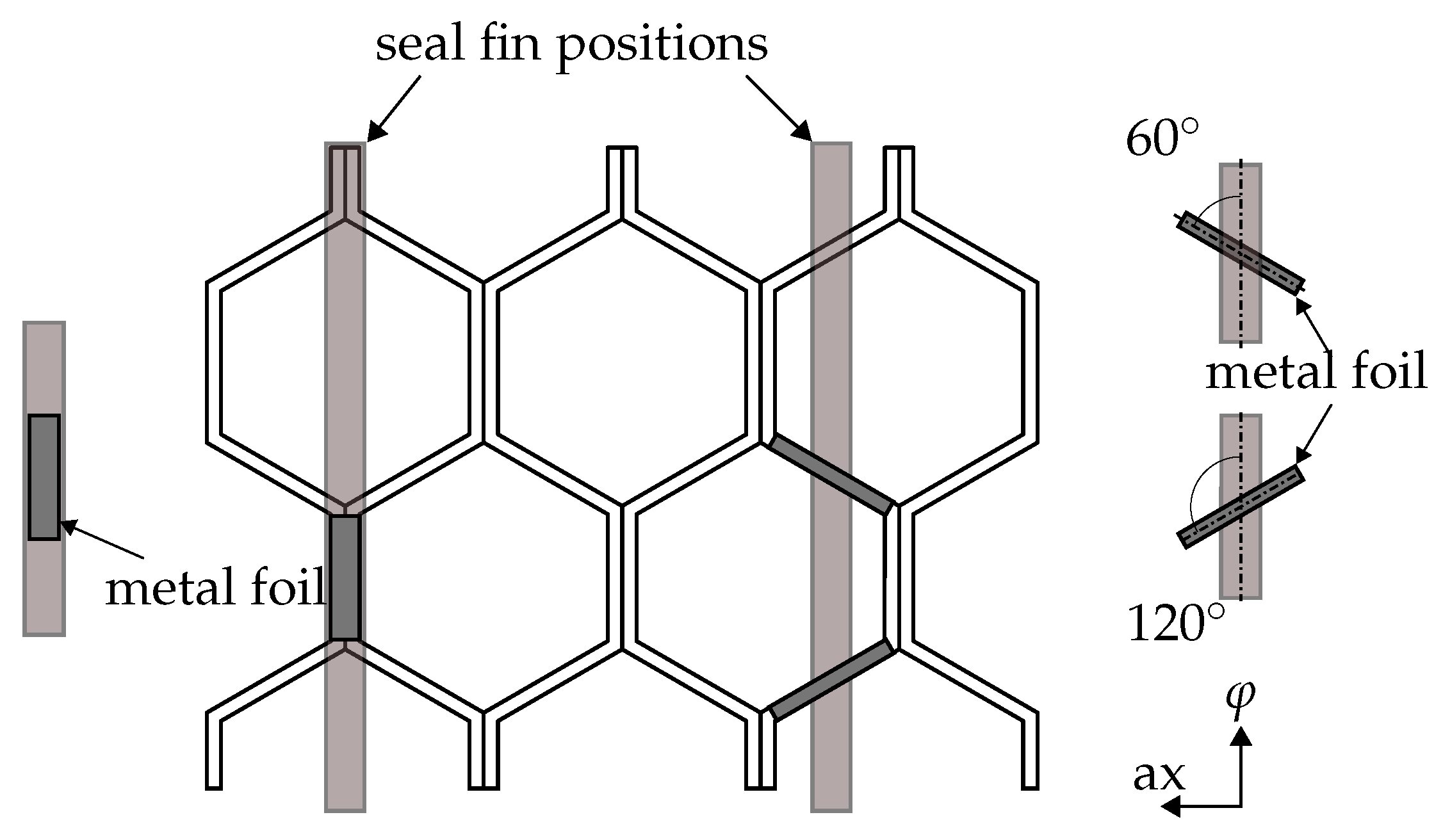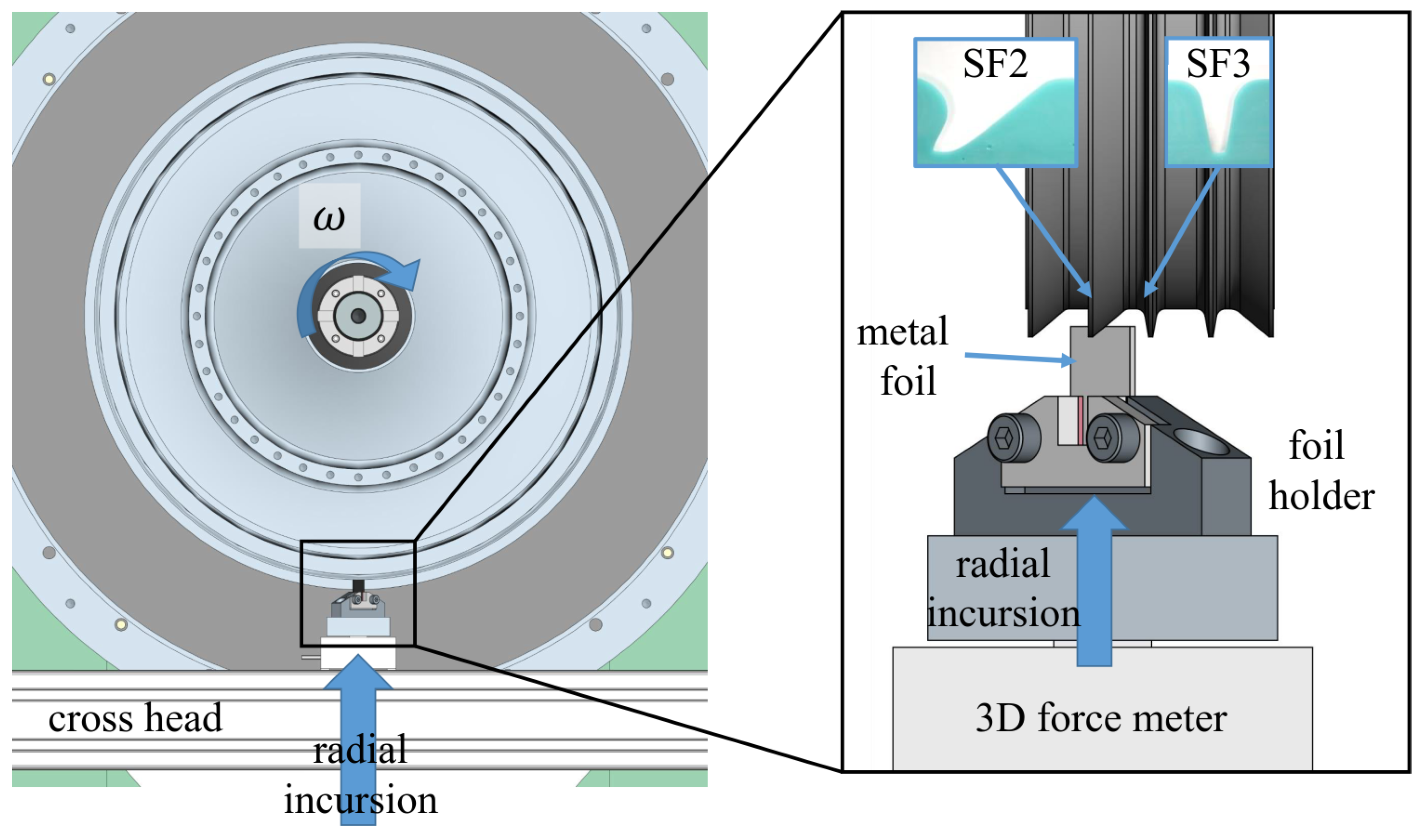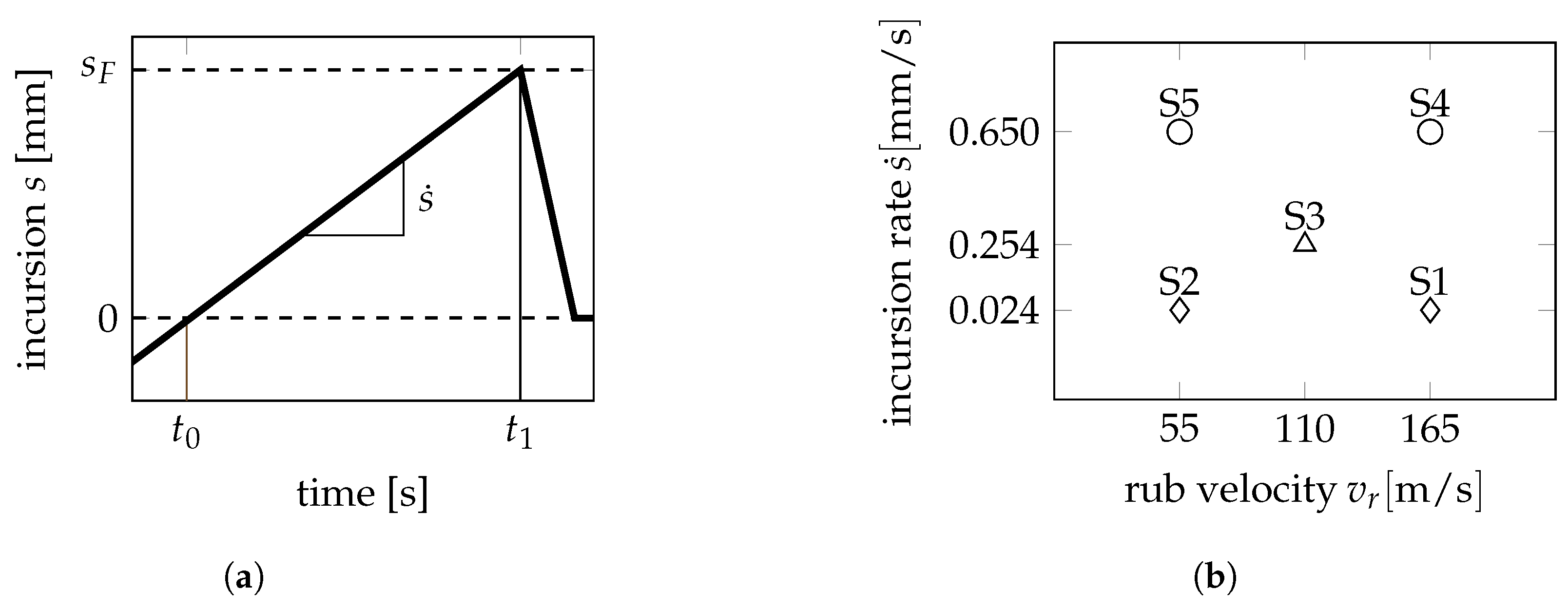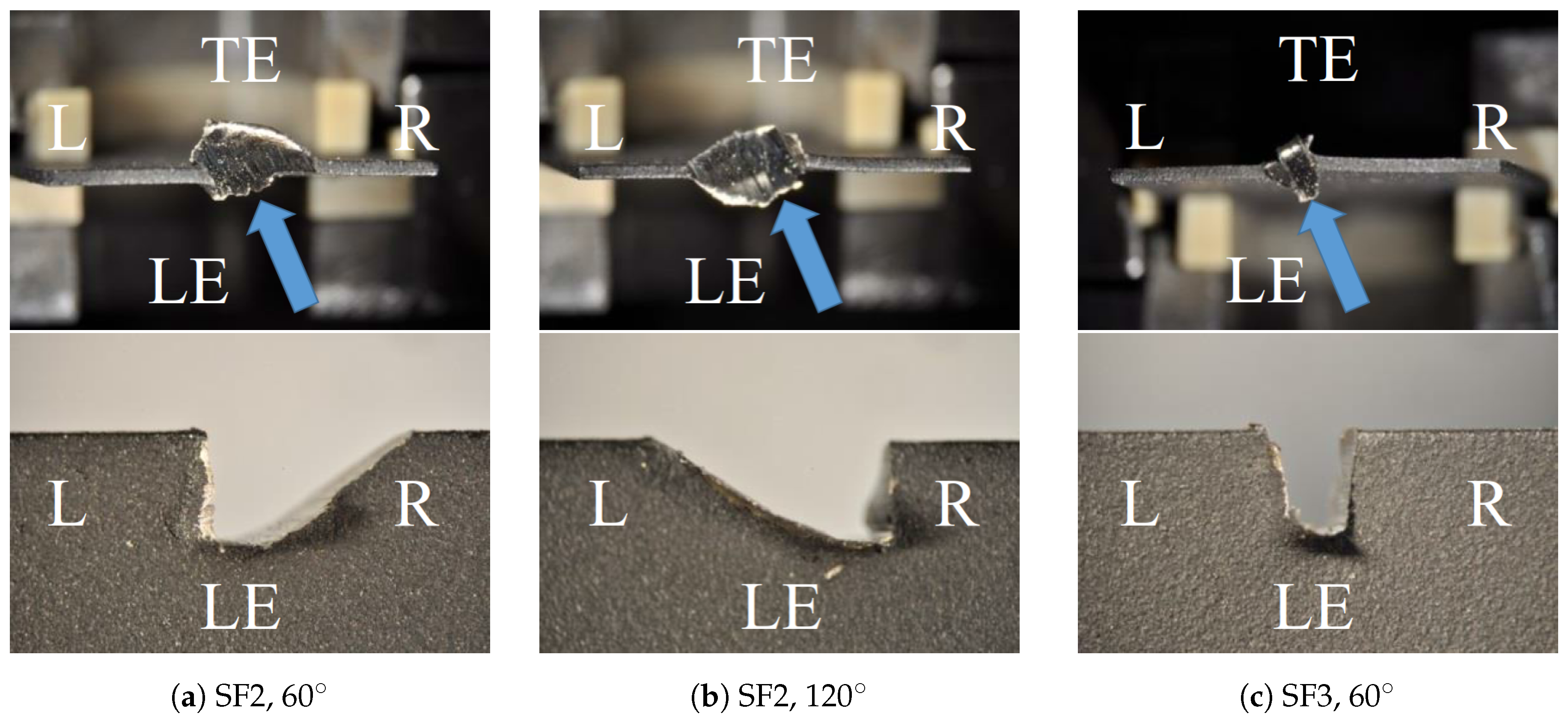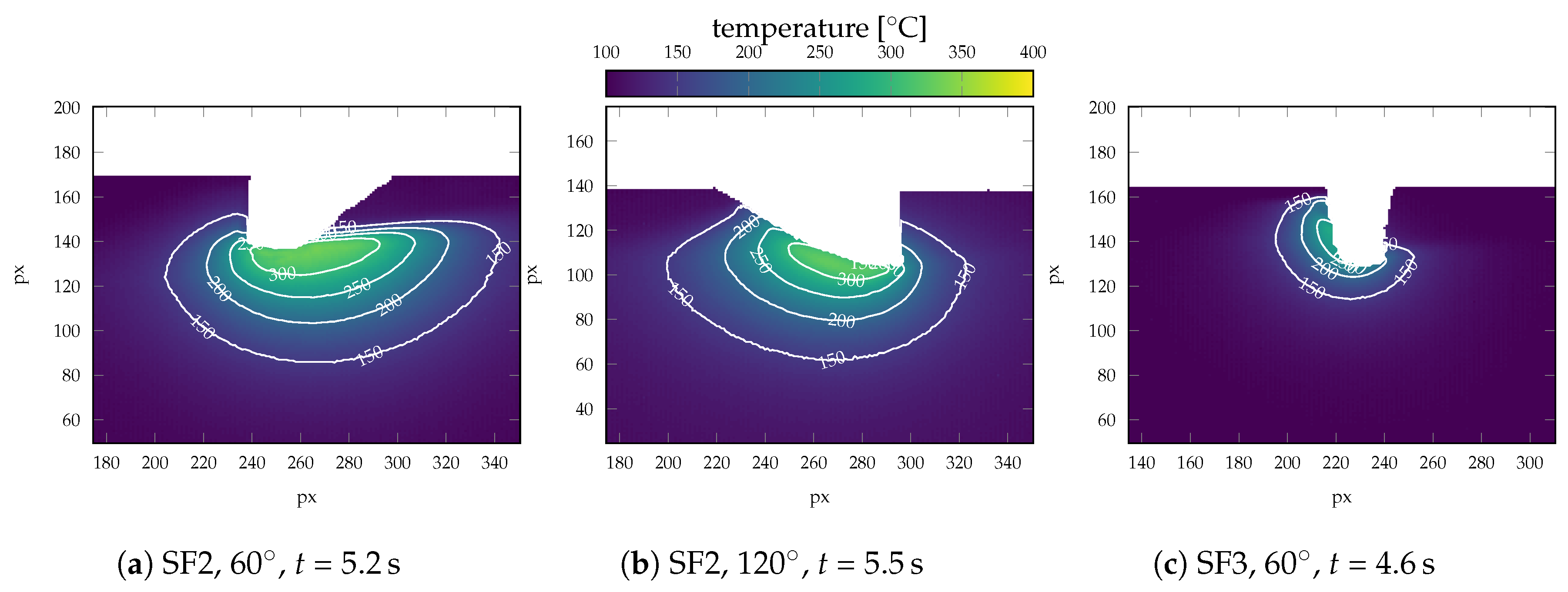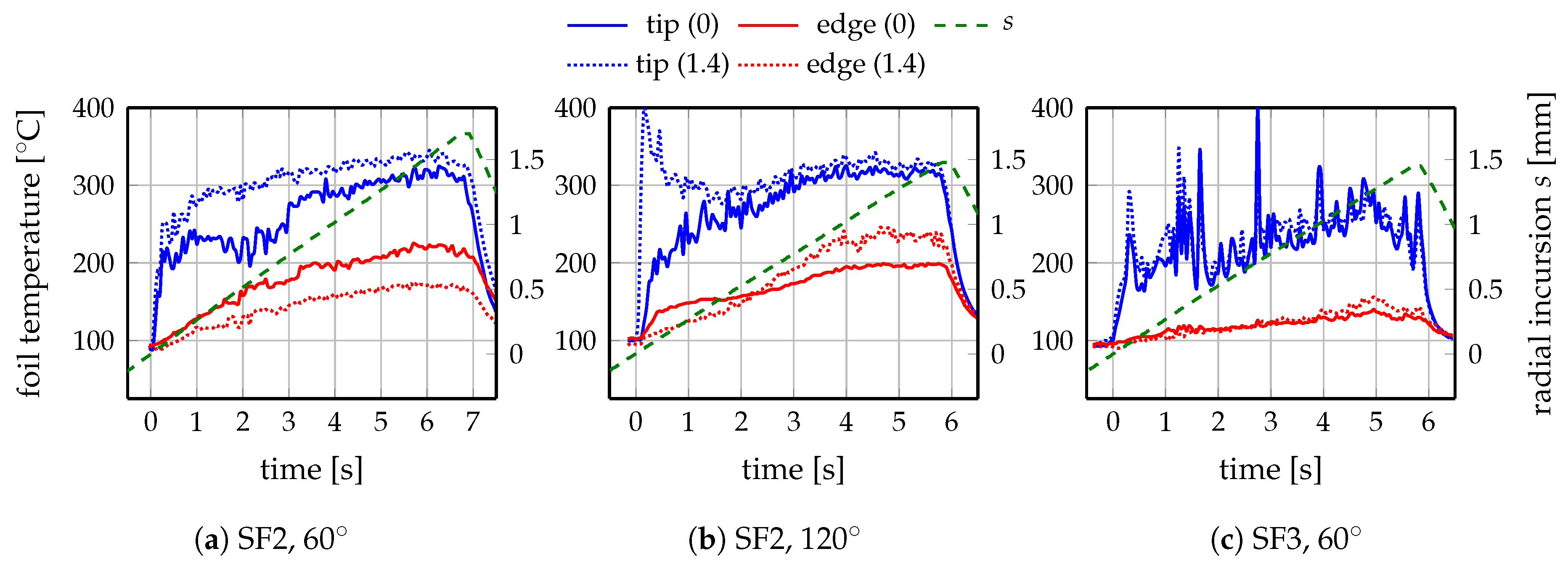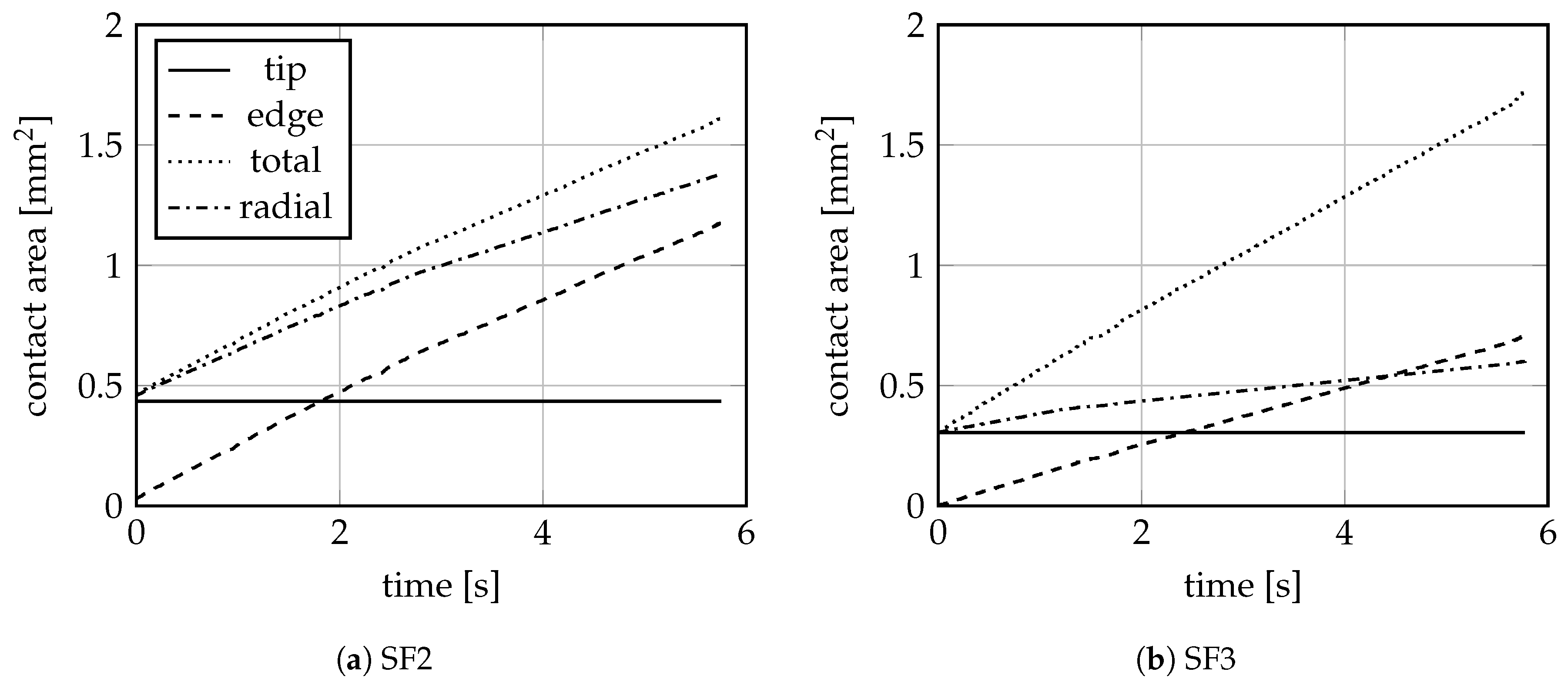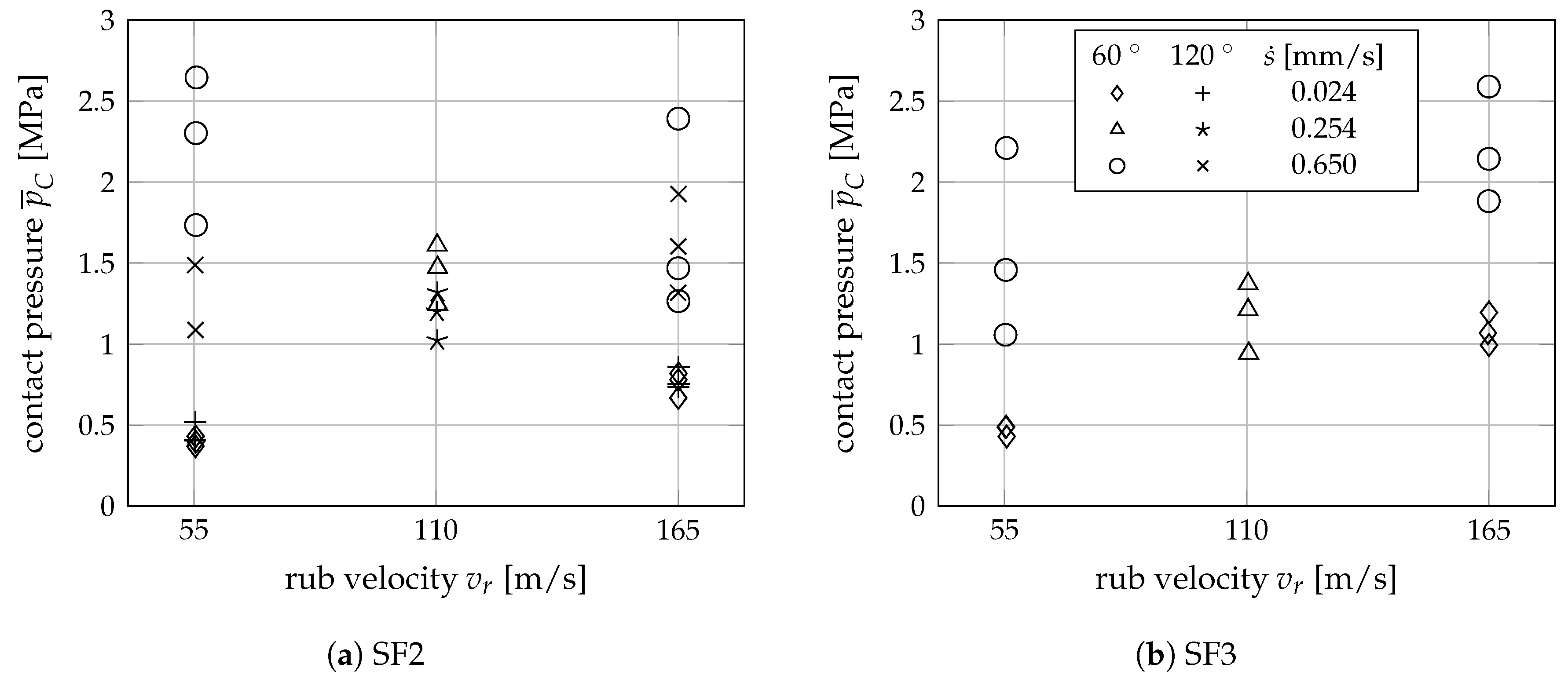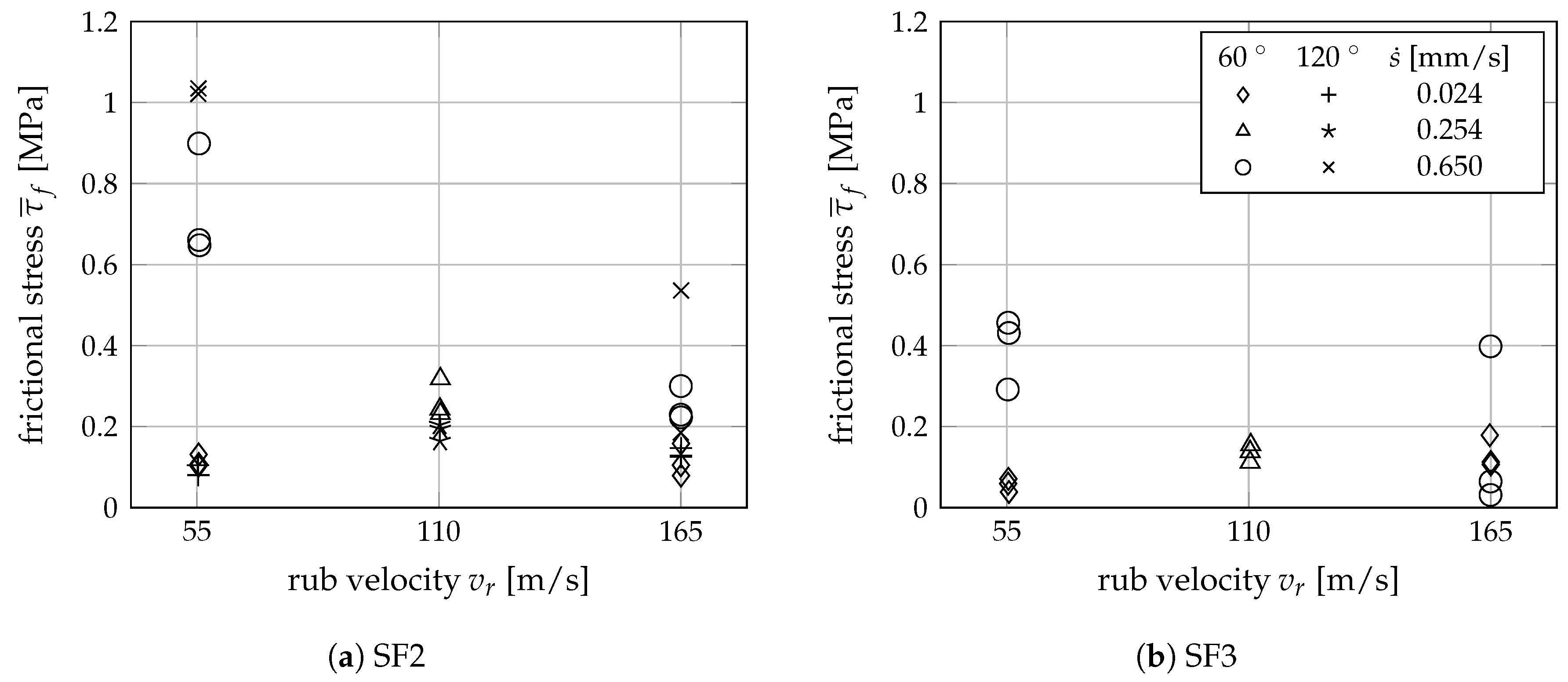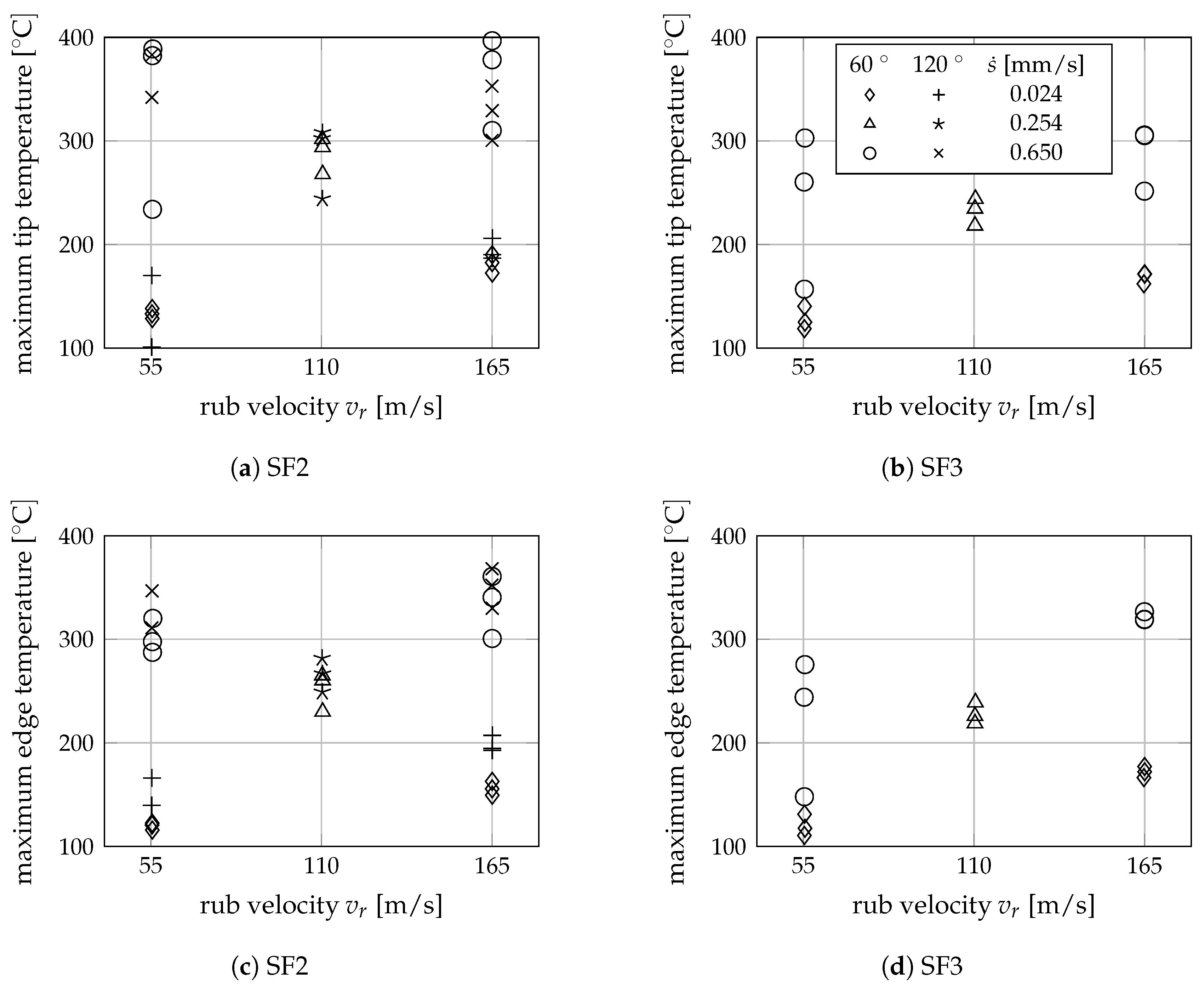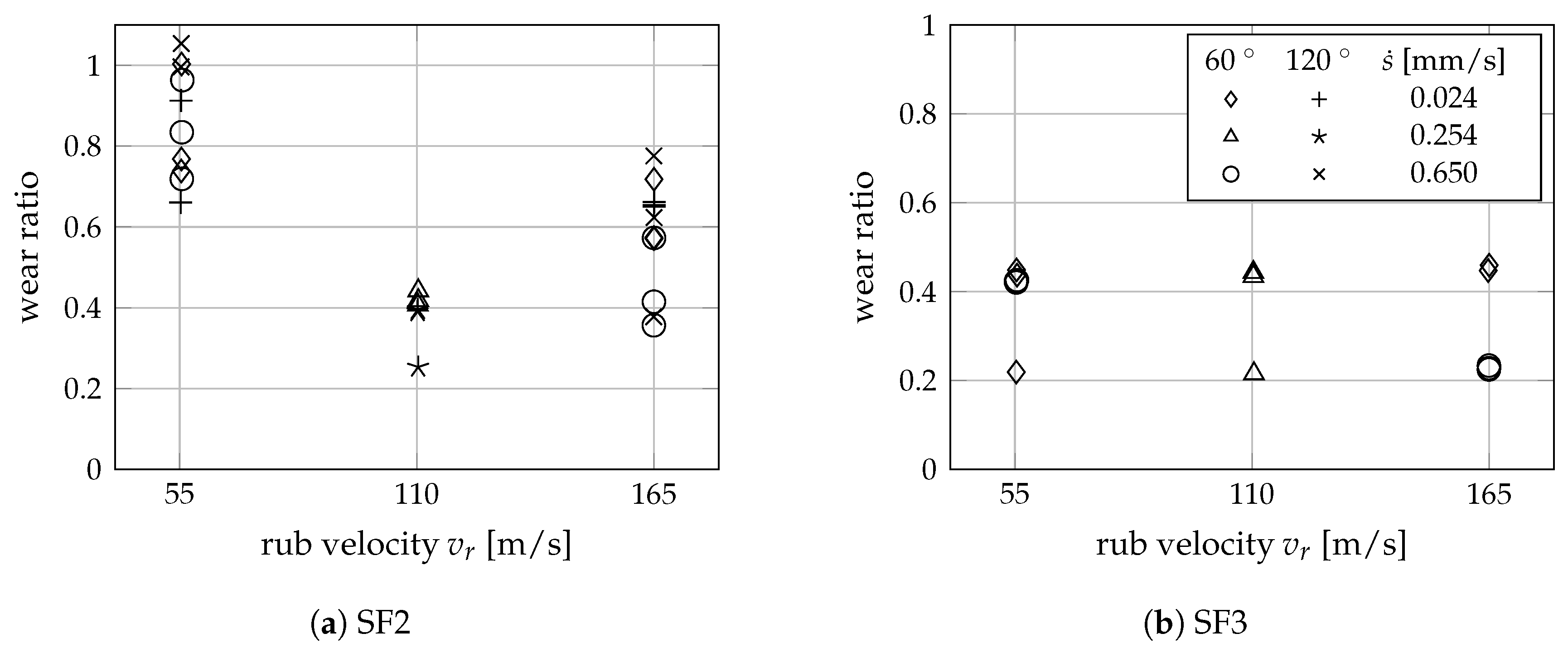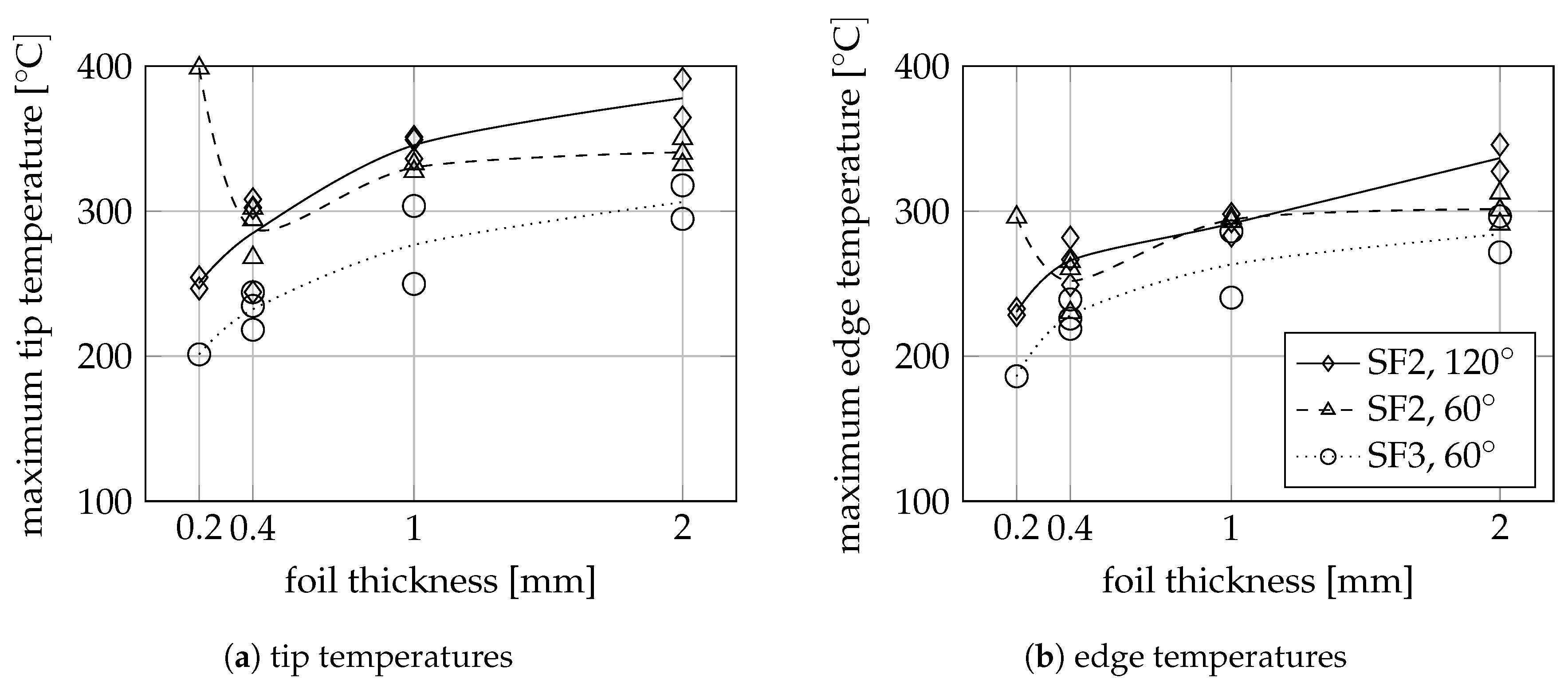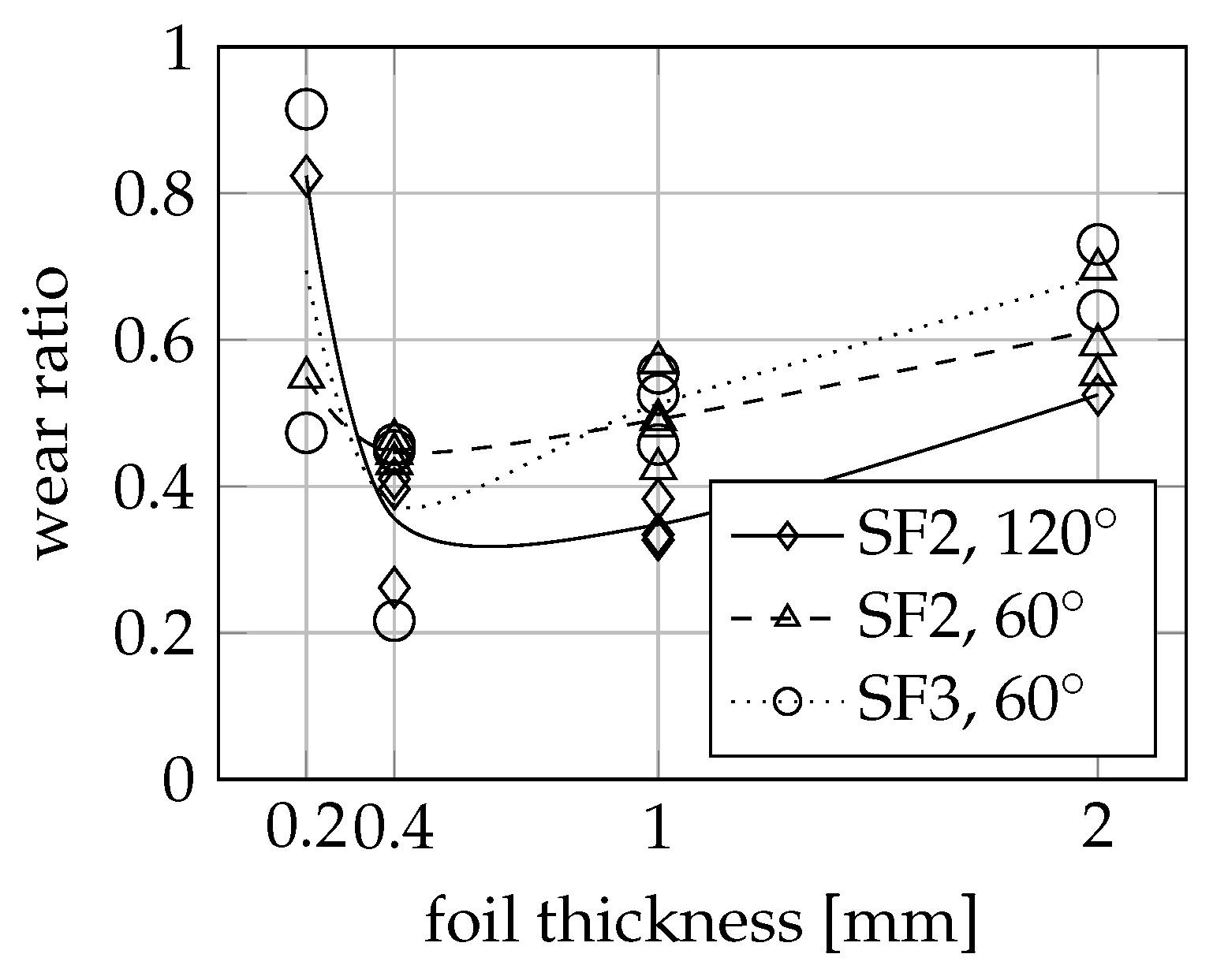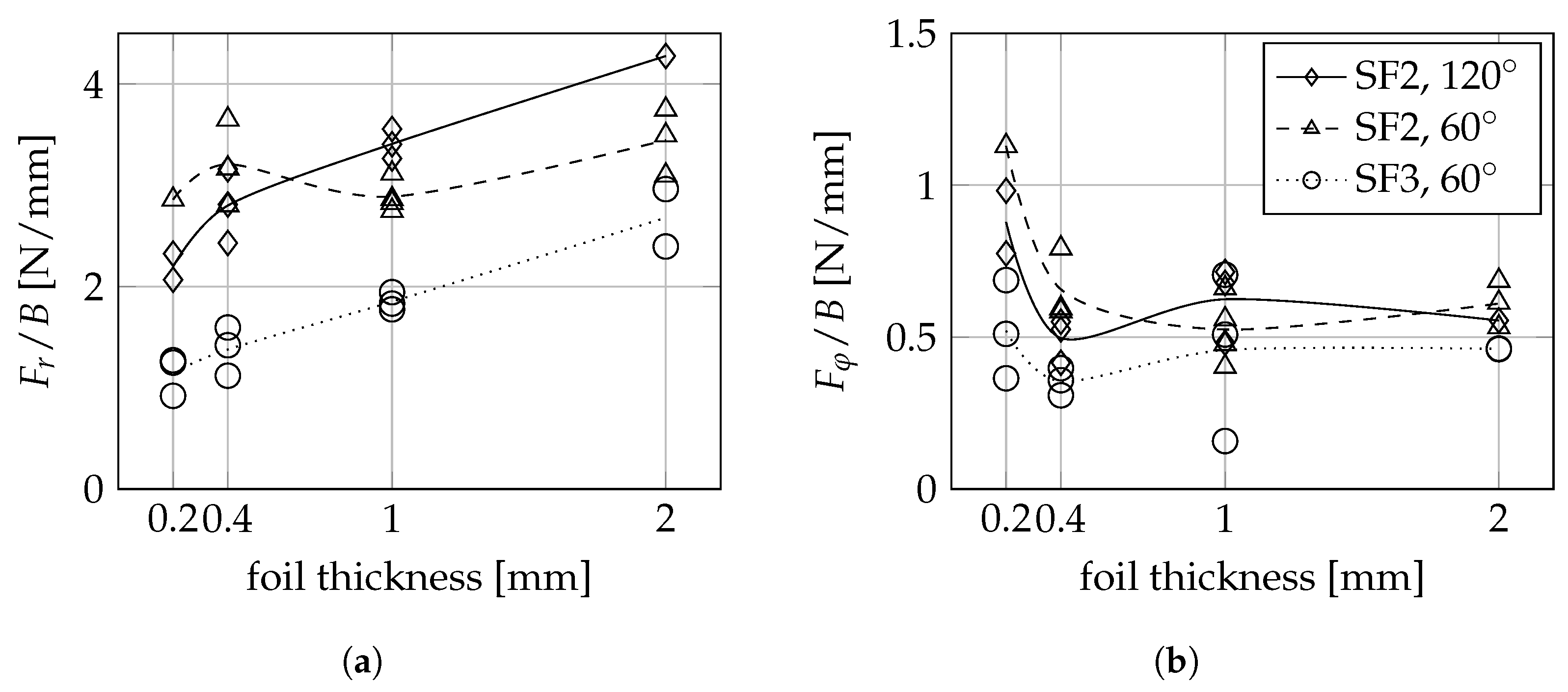This section presents and discusses the resulting wear, forces, and temperatures of the tests. Experiments were carried out with both an inclined and a perpendicular seal fin, as shown in
Figure 4. The investigation of two different configurations (60
, 120
) allows the measurement of the temperature evolution for both the front edge and rear edge of seal fin SF2. The final incursion depth
was kept constant at
. In the following subsections, selected test runs of rub scenario 3 (S3, 110 m/s rub velocity,
mm/s incursion rate,
foil thickness) are discussed to get insights into the friction and wear behavior of the studied system. In order to interpret the resulting forces, a geometrical analysis of the system is demonstrated. Then the results for all rub scenarios are presented and discussed.
3.1. Rub Scenario S3—Different Seal Fins and Foil Orientation
In the selected test runs, the resulting forces, images from the IR camera, and extracted temperatures from the IR camera for the reference rub test are shown. The wear profile of the metal foil after the rub test in
Figure 5 helps to understand the IR thermo camera images. Plastic deformation wear can be identified by shear lips both on the leading edge (LE) and the trailing edge (TE) for all rub orientations. Comparing both seal fin geometries, the plastic wear on the side surface(s) of the rub groove is much more pronounced for the inclined seal fin SF2. On the one hand, this is due to the larger volume of metal foil material that has to be worn away or pushed aside from the seal fin. On the other hand, this observation suggests higher temperatures, and hence lower yield strength, near the contact area on the rear surface of seal fin SF2. Higher local friction temperatures lead to more local plastic deformation wear on the sharp edge. This demonstrates the importance of heat removal from the contact zone and the resulting metal foil friction temperatures.
Figure 6 depicts the contact forces in radial (
) and tangential (
) directions over time for a metal foil thickness
B of
mm. The green graph indicates the radial incursion
s in
. The parallel rub tests presented in [
18] had shown that, despite the continuous increase in radial incursion, a steady wear state develops after a characteristic peak value in the contact forces. This distinction of two phases cannot be observed for the slanted position. There is a smaller peak at the beginning of the friction contact, but, especially for the inclined seal fin (SF2) in
Figure 6a,b, both radial and tangential forces continue to increase over time. This trend is not so pronounced for the perpendicular seal fin (SF3) in
Figure 6c, which can be explained by the increasing geometric contact area with increasing incursion rate.
The corresponding IR images of the metal foil front face for reference rub scenario S3 are depicted in
Figure 7. Only temperatures on the left-hand edge could be determined by means of IR imaging, because the view is partially blocked by the seal fin (see
Figure 4). In
Figure 7a, the inclined seal fin with 60
foil orientation is shown. It can be clearly seen that the temperature distribution at the tip is much more pronounced than the temperature at the left-hand edge. This is an indication that the front edge of the seal fin is not involved in the rubbing process. The temperature distribution of the inclined seal fin with 120
foil orientation in
Figure 7b and the perpendicular seal fin in
Figure 7c indicate that there is a contact and frictional heat fluxes are released.
In order to quantify the temperature distribution, an algorithm was used to extract the maximum foil temperatures at the seal fin tip and the front edge.
Figure 8 shows the transient development for the temperature of seal fin tip and front edge directly at the contact and at a distance of
mm perpendicular to the respective contact surface. In the tests on the inclined seal fin SF2 with 60
foil orientation in
Figure 8a, the maximum temperatures at the edge
correspond to the temperatures measured on the small, visible section of the rear surface.
In contrast to the parallel foil orientation, where the maximum temperatures are always around 800
, the measured friction temperatures for the slanted foil position are considerably lower with maximum temperatures under 400
. This can be attributed to the improved heat transfer to the surrounding metal foil through conduction. Also, the convective heat transfer can be expected to be larger, as air is swirled directly onto the front face of the metal foil by rotor windage. The tip temperatures of the inclined seal fin SF2 are almost identical for both foil angles 60° and 120
in
Figure 8a,b. The maximum temperatures at the rear edge seem to be slightly higher than those at the fin tip. This is particularly true for the beginning of the rub process for the 60
foil orientation on SF2 in
Figure 8b. In contrast, the temperatures at the edge and fin tip seem to be more similar for the perpendicular seal fin SF3 in
Figure 8c.
Both the IR camera pictures in
Figure 7 and the extracted temperatures in
Figure 8 show that temperatures are approximately 50
lower for the perpendicular seal fin SF3 and fluctuate much more in comparison. An explanation for this can be found in a repeating shift of contact from the seal fin tip to the edge surfaces, for example, due to an opening and closing of the contact caused by a combination of thermal expansion and wear or adhesive material transfer. For the inclined seal fin SF2, the measured temperatures are much steadier. As a result of increasing contact area and resulting forces over the rub duration, the temperatures in the contact zone take longer to approach a steady-state phase.
The plastic deformation wear of the metal foil must be taken into account when interpreting the foil temperatures near the contact area. Therefore, a more reliable comparison of the foil temperatures can be made for the foil temperatures at a
mm distance from the contact surface in
Figure 8. The foil temperatures at the
mm distance from the contact surface are clearly higher for the inclined seal fin SF2. Although the contact area at the tip is similar for both the inclined and perpendicular seal fin, the total heat input into the metal foil seems to be larger for the inclined seal fin. This indicates that the total frictional heat generated in the contact zone is larger for the inclined seal fin. However, it must be pointed out that the measurement error of the IR camera increases with decreasing foil temperature. Also, due to the grinding of the seal fins after each rub test, the width of the inclined seal fin tip increased more than the tip width of the perpendicular seal fin tip with increasing number of experiments.
3.3. All Test Runs for Metal Foil Thickness 0.4 mm
The effects of rub velocity and incursion rate on the averaged resulting contact pressure
for each seal fin geometry with foil thickness of
mm are shown in
Figure 11. The contact pressure was calculated by dividing the measured radial force by the projected radial contact surface,
and averaging over the rub duration. Similar to the parallel rub tests, the contact pressure increases with increasing incursion rate, irrespective of the seal fin geometry. However, as opposed to the parallel rub tests, the radial forces increase with increasing rub velocity. This trend is particularly pronounced for the low incursion rates of
mm/s, irrespective of the seal fin geometry. The contact pressure of the reference scenario S3 suggests a linear relationship between the rub conditions and the resulting radial forces. The resulting contact pressures are very similar for both seal fin geometries, which shows that, according to Equation (
1), the resulting radial forces are larger for the inclined seal fin geometry SF2. Overall, a reliable comparison between both seal fin geometries is difficult because of uncertainties in estimating the projected radial contact surface and differentiation between force components acting on each edge, contributing to the resulting force.
The corresponding frictional stress was determined by dividing the measured tangential force by the total contact area,
and averaging over the rub duration. The results are depicted in
Figure 12. Here, the average frictional stress decreases with increasing rub velocity for high incursion rates, while, for low incursion rates, the frictional stress slightly increases with rub velocity. This trend is the same for both seal fin geometries. While for small rub velocities of 55 m/s the incursion rate has an increasing effect on the resulting frictional stresses, this trend is not so obvious for higher rub velocities of 165 m/s. Because the total contact area
is similar for both seal fin geometries (see
Figure 10), the resulting friction forces are significantly lower for the perpendicular seal fin SF3, even though the contact pressure was very similar. This indicates that the forces acting on the front and rear edge are small compared to the tip forces.
The time-averaged maximum tip and edge foil temperatures in the contact surface are plotted in
Figure 13, respectively. They show very similar trends to the contact pressures in
Figure 11. For high incursion rates of
mm/s, the measured frictional stresses were observed to decrease with increasing rub velocity, being very similar to the frictional stresses obtained for small incursion rates at high rub velocities of 165 m/s in
Figure 12. This suggests that the resulting friction temperatures on the foil are rather more proportional to the resulting contact pressures than to the resulting frictional stresses. Further studies are required to explain this unexpected trend. For the lowest incursion rate of
mm/s, the fin tip and edge temperatures seem to be very similar for both the perpendicular and the inclined seal fin. For higher incursion rates, the maximum tip temperatures in the contact zone are slightly higher than the maximum edge temperatures (approximately 25
to 50
). The tip temperatures are almost identical for the inclined seal fin SF2 for both foil orientations of 60° and 120
in
Figure 13a. Both tip and edge temperatures seem to be about 50
lower for the perpendicular seal fin than for the inclined seal fin, irrespective of the rub scenario. This may be related to the effect of plastic deformation, which is slightly different for both seal fin geometries (see
Figure 5). Overall, the metal foil friction temperatures measured for the slanted foil orientation are significantly smaller than for the parallel foil orientation, which were always beyond 700
in the contact region.
To get an indication on the amount of abrasive wear
to total wear
, a total wear volume
was defined, such that the rub groove geometry corresponds to the seal fin geometry at the end of the rub process (see
Figure 9). By converting the global weight loss determined for the metal foil into an equivalent volume using the material’s density, a resulting wear ratio
can be obtained. It indicates the amount of abrasive wear to total wear, similar to the tests with parallel metal foil orientation. As the total volume of the rub groove is much smaller for the perpendicular seal fin SF3, the measurement error for the weight loss is larger, making interpretation more difficult. The wear ratios determined for
mm metal foil thickness are shown in
Figure 14. Different trends can be observed for both seal fin geometries. For the inclined seal fin SF2, the percentage of abrasive wear seems to be a function of the rub velocity, similar to what was observed for the tests with parallel foil orientation. For the perpendicular seal fin SF3, the rub velocity only seems to affect the wear ratio for high incursion rates of
mm/s. This consideration disregards the amount of adhesive wear observed during the experiments.
Overall,
Figure 11,
Figure 12,
Figure 13 and
Figure 14 demonstrate the repeatability of the rub tests, which allows for identification of the effect of rub scenario, fin geometry, and foil orientation. The test results for all rub scenarios suggest an interaction between the rub velocity and incursion rate, which is different for inclined and perpendicular seal fins. This indicates that the friction temperatures have an influence on the associated wear mechanisms. As discussed for the parallel rub tests [
18], softening of the material and possible oxidation may decrease friction effects.
This seems to be the case only for higher average maximum foil temperatures, beyond 250
, reached for higher incursion rates. The fact that only the resulting radial force correlates with foil temperatures may indicate that a large amount of friction heat is generated by the plastic deformation processes, irrespective of the friction force. Plastic deformation of the metal foil in the contact region, depicted in
Figure 5, can be observed for all rub scenarios and seal fin geometries. Especially for the inclined seal fin and the rub scenarios S3 and S1/S4 with rub velocities of 110 m/s and 165 m/s, respectively, plastic deformation wear is more pronounced than for the low rub velocities in scenario S2/S5. In fact, for low rub velocities, the metal foil was bent by the rotating seal fin for the small metal foil thicknesses of
mm, suggesting lower metal foil temperatures and/or high friction forces at the side edge. In fact, this bending effect may be one possible reason explaining the trends observed for the contact and friction forces, metal foil temperatures, and wear ratios discussed previously.
The wear patterns clearly show less plastic deformation for the rub scenarios with low rub velocity, also suggesting lower friction temperatures in the contact region. These observations match the higher percentages of abrasive wear observed for these rub scenarios (
Figure 14). For the inclined seal fin SF2, the plastic deformation wear on the seal fin side surface appears to be slightly different for the metal foil inclination of 60° and 120
. On the one hand, this may be due to the differences in seal geometry, which was much wider and rounder for the rub tests with 120
metal foil orientation (see
Figure 9). On the other hand, this difference may be due to the effect of the sharp metal foil angle restricting the heat removal from the contact zone.
Another interesting observation for the inclined seal fin SF2 is that the metal foil seems to be pushed axially towards the front edge of the seal fin during rubbing, as indicated by the slightly inclined edge of the rub groove on the front side. This is presumably due to the axial force affecting the inclined rear seal fin edge. As a consequence, the small corner radius at the front edge of the seal fin tip is also involved in the rub process, as was also indicated by the temperature field measurements on the metal foil obtained with the IR camera. The contribution of the small leading edge to the resulting axial force makes interpretation of the various force components very difficult.
3.4. Effect of Foil Thickness for Rub Scenario S3
In this section, the effect of metal foil thickness on the system’s rub behavior is discussed for reference rub scenario S3.
Figure 15 shows the effect of foil thickness on the averaged foil tip and edge temperatures for all combinations of seal fin geometries and foil orientations. First of all, it can be seen that the average foil temperatures increase slightly with foil thickness, true for both fin geometries and foil orientations. For example, the average foil temperature near the fin tip in
Figure 15a increases by approximately 100
with a foil thickness varying from 0.2 to 2.0 mm. This can be attributed to the increase in the ratio of total friction heat to convective cooling. While the convective heat transfer coefficient approximately remains the same irrespective of the metal foil thickness, the total amount of friction heat released in the contact region increases with increasing metal foil thickness. Especially for rub tests with low rub velocity and high incursion rate, the metal foils of
mm thickness occasionally bent in the direction of rotor rotation. Therefore, the high temperatures measured for seal fin SF2 with 60
metal foil orientation at
mm metal foil thickness may be an outlier. For all metal foil thicknesses, the metal foil temperatures are about 30
to 50
lower for the perpendicular seal fin SF3 compared to the inclined seal fin SF2 at both the fin tip and fin edge, as observed previously. For the inclined seal fin SF2, the temperatures on the rear edge are approximately 30
to 50
lower than at the seal fin tip. For the perpendicular seal fin SF3, however, the temperatures are very similar at the fin tip and edge.
Similar trends to the metal foil temperatures can be observed for the ratio of abrasive wear to total wear, which also increases with foil thickness, as shown in
Figure 16. Only for the thinnest foils (
mm) does abrasive wear seem to increase significantly. However, it must also be pointed out that the measurement uncertainty increases with decreasing foil thickness, as the
mg resolution of the scales was too low to resolve small material losses of only a few milligrams (for example, 2 mg for SF2 and 120
and 1 mg for SF3 with
mm foil thickness). As opposed to the parallel rub tests, where the wear ratio is significantly lower, with about 0 and 0.2, the amount of abrasive wear for metal foil thickness 0.4 mm is higher for the slanted foil orientation. For large and small foil thicknesses (2 mm and 0.2 mm), the amount even increases. The smaller amount of plastic wear for the slanted rub tests with respect to the parallel rub tests may be attributed to the lower friction temperatures and hence higher plastic yield limit. As a consequence, abrasive wear is more important. The same explanation applies to the larger plastic wear observed for the hotter inclined SF2 with respect to the perpendicular SF3. It is interesting to note that, in contrast to the rub tests with parallel metal foil orientation, an increase in the metal foil friction temperatures does not seem to result in an increase in plastic deformation wear.
Figure 17 shows the measured time-averaged forces divided by the foil thickness B for rub scenario S3 and for all foil thicknesses. Similar to the foil temperatures, the normalized radial force increases with foil thickness B, again indicating a correlation (
Figure 17a). A different behavior can be seen for the time-averaged tangential forces. They decrease with increasing foil thickness and seem to approach a steady state (
Figure 17b). Overall, the forces divided by foil thickness are smaller for the perpendicular seal fin SF3. According to
Figure 10, the total nominal contact area for the perpendicular SF3 is slightly larger than for the inclined SF2, as both the front and rear fin edge are in contact simultaneously. As a consequence, it is surprising that the normalized tangential force is smallest for the perpendicular SF3 in
Figure 17b.
